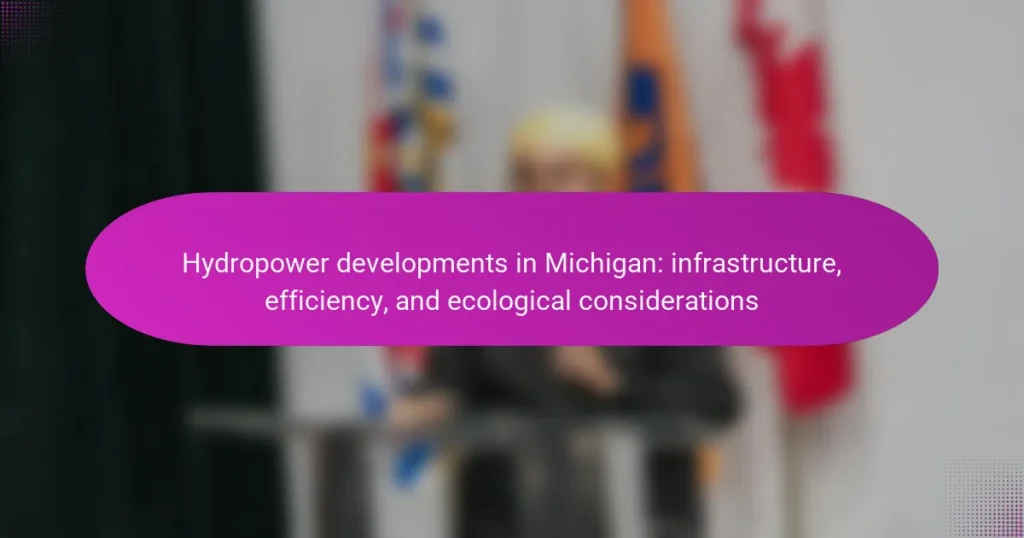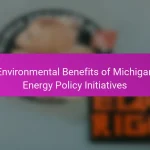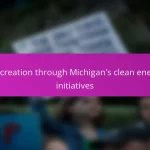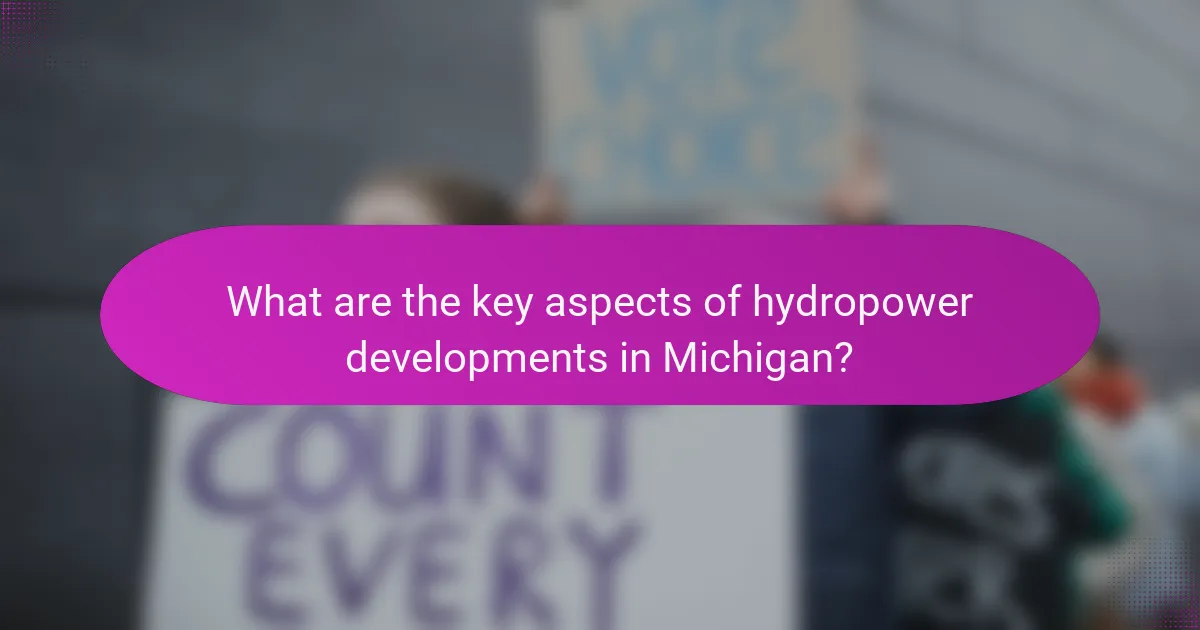
What are the key aspects of hydropower developments in Michigan?
Key aspects of hydropower developments in Michigan include infrastructure, efficiency, and ecological considerations. Michigan has over 100 hydropower facilities, primarily located on rivers. These facilities generate renewable energy, contributing to the state’s energy portfolio. The infrastructure involves dams and turbines designed to harness water flow effectively. Efficiency rates for these plants vary, with modern facilities achieving over 90% efficiency. Ecologically, hydropower development in Michigan must consider fish migration and water quality. Regulations require environmental assessments before construction. The state emphasizes sustainable practices to mitigate ecological impacts. Overall, hydropower plays a significant role in Michigan’s renewable energy landscape.
How does hydropower infrastructure function in Michigan?
Hydropower infrastructure in Michigan functions by converting the energy of flowing water into electricity. This process typically involves the construction of dams on rivers to create reservoirs. Water is released from these reservoirs through turbines, which spin and generate electricity.
Michigan has several hydropower plants, with a significant number located on the Muskegon, Manistee, and St. Joseph rivers. The total capacity of hydropower facilities in Michigan is approximately 1,200 megawatts. These plants contribute to the state’s renewable energy portfolio.
Additionally, hydropower infrastructure in Michigan is regulated to ensure environmental protection. This includes maintaining fish passage and minimizing ecological disruption. The state also promotes the modernization of aging facilities to improve efficiency and reduce impact.
What are the main components of hydropower infrastructure?
The main components of hydropower infrastructure include dams, turbines, generators, and transmission lines. Dams create a reservoir that stores water. Turbines convert the kinetic energy of flowing water into mechanical energy. Generators then transform this mechanical energy into electrical energy. Transmission lines carry the generated electricity to the grid. Each component plays a critical role in the overall efficiency of hydropower systems. For instance, the design of the dam influences water flow and energy production. The capacity of turbines and generators affects how much electricity can be generated.
How does the design of these components impact efficiency?
The design of hydropower components directly impacts energy conversion efficiency. Efficient designs minimize energy losses during water flow and electricity generation. For instance, optimized turbine shapes enhance water flow dynamics, increasing rotational speed and energy output. Additionally, advanced materials reduce friction and wear, prolonging component lifespan and maintaining efficiency over time. Research indicates that well-designed penstocks can reduce pressure losses by up to 20%. Proper alignment and sizing of components ensure optimal performance under varying water conditions. Therefore, effective design choices lead to higher overall energy production from hydropower systems.
What efficiency metrics are important for hydropower in Michigan?
Key efficiency metrics for hydropower in Michigan include capacity factor, generation efficiency, and water use efficiency. The capacity factor measures the actual output versus the potential output over time. In Michigan, hydropower plants typically exhibit capacity factors ranging from 30% to 50%. Generation efficiency indicates the ratio of electrical energy produced to the energy available from the water flow. In Michigan, generation efficiencies can reach up to 90% in optimal conditions. Water use efficiency assesses how effectively water resources are utilized for electricity generation. This metric is crucial given Michigan’s diverse water bodies and seasonal variations. These metrics collectively inform the performance and sustainability of hydropower facilities in the state.
How is efficiency measured in hydropower systems?
Efficiency in hydropower systems is measured by the ratio of useful electrical energy output to the potential energy input from water. This is typically expressed as a percentage. The formula used is: Efficiency (%) = (Output Power / Input Power) x 100. Input power is calculated based on the water flow rate and the height from which the water falls, known as the hydraulic head. Output power is the electrical energy produced by the turbine and generator. High-efficiency systems can achieve efficiencies above 90%, while older systems may have lower efficiencies. Regular maintenance and technological advancements can enhance the efficiency of hydropower systems.
What factors influence the efficiency of hydropower plants?
The efficiency of hydropower plants is influenced by several key factors. These include water flow rate, head height, and turbine design. Water flow rate refers to the volume of water passing through the turbine per unit of time. Higher flow rates generally lead to increased energy generation. Head height is the vertical distance that water falls, which contributes to the potential energy converted into electricity. Greater head heights can enhance efficiency.
Turbine design also plays a critical role. Different turbine types, such as Kaplan, Francis, and Pelton, are optimized for specific conditions. The choice of turbine affects how effectively the kinetic energy of water is converted into mechanical energy. Additionally, maintenance practices and the condition of the infrastructure can impact operational efficiency. Regular maintenance ensures that turbines and generators function optimally.
Environmental factors, such as sedimentation and water temperature, can also affect efficiency. Sediment buildup can reduce water flow and turbine performance. Water temperature influences the density and viscosity of water, which can impact energy conversion. Understanding these factors is essential for optimizing the performance of hydropower plants.
What ecological considerations are associated with hydropower developments?
Ecological considerations associated with hydropower developments include habitat alteration, fish migration disruption, and water quality impacts. Hydropower projects can change natural river flow patterns, affecting aquatic ecosystems. Altered flow can lead to sedimentation changes and habitat loss for species. Dams may obstruct fish migration, impacting populations of species such as salmon. Additionally, changes in water temperature and oxygen levels can harm aquatic life. These ecological impacts necessitate careful planning and mitigation strategies to minimize harm. For example, fish ladders and bypass systems can help facilitate migration around dams. Studies show that these considerations are crucial for maintaining biodiversity in affected areas.
How do hydropower plants affect local ecosystems?
Hydropower plants significantly affect local ecosystems by altering water flow and habitat structures. They can disrupt the natural migration patterns of fish species. This disruption often leads to a decline in fish populations. Additionally, changes in water temperature and sediment transport can harm aquatic life. Hydropower plants may also cause flooding in surrounding areas, affecting terrestrial habitats. These ecological impacts are documented in studies, such as the U.S. Geological Survey’s research on river ecosystems. This research highlights the importance of considering ecological factors in hydropower development.
What measures are taken to mitigate ecological impacts?
Hydropower developments in Michigan implement several measures to mitigate ecological impacts. These measures include the installation of fish ladders to facilitate fish migration. Additionally, environmental flow management is employed to maintain river ecosystems. Regular monitoring of water quality helps detect and address pollution. Sediment management practices are used to prevent habitat degradation. Collaborative efforts with environmental organizations ensure compliance with ecological standards. These strategies are designed to balance energy production with environmental preservation.
How do hydropower developments in Michigan compare to other energy sources?
Hydropower developments in Michigan are a significant part of the state’s energy mix, but they are less prevalent compared to other energy sources like natural gas and coal. In 2021, hydropower contributed about 3% of Michigan’s total electricity generation. This is considerably lower than natural gas, which accounted for approximately 40%, and coal, which made up around 14%.
Hydropower in Michigan is primarily generated from river systems and dams, which have environmental implications. Other energy sources, such as wind and solar, have seen rapid growth in recent years. Wind energy contributed about 11% to the state’s electricity generation in 2021.
Hydropower developments are often limited by geographical factors and existing infrastructure. In contrast, natural gas plants can be built more flexibly. Overall, while hydropower is a renewable source, it plays a smaller role in Michigan’s energy landscape compared to fossil fuels and emerging renewable technologies.
What future trends are anticipated for hydropower in Michigan?
Future trends for hydropower in Michigan include increased investment in infrastructure upgrades and modernization. The state aims to enhance efficiency through advanced technologies. There is a growing focus on integrating hydropower with other renewable energy sources. Additionally, ecological considerations are leading to improved environmental assessments of hydropower projects. The Michigan Department of Environment, Great Lakes, and Energy supports these initiatives. Increased regulatory support is expected to facilitate new hydropower projects. These trends align with Michigan’s broader goals for renewable energy and sustainability.
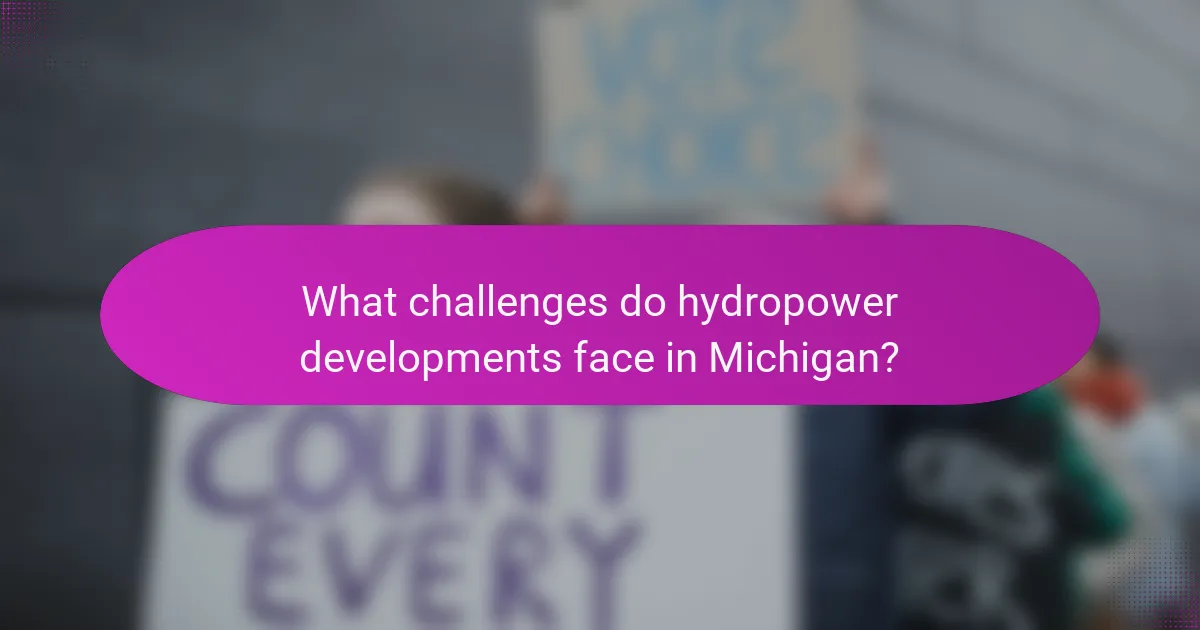
What challenges do hydropower developments face in Michigan?
Hydropower developments in Michigan face several challenges. Regulatory hurdles complicate project approvals and environmental assessments. Aging infrastructure requires significant investment for upgrades and maintenance. Ecological concerns arise from potential impacts on local wildlife and water quality. Competition from other energy sources can hinder investment in hydropower. Community opposition may arise due to concerns about land use and environmental effects. Limited funding and financial incentives can restrict project feasibility. Climate change also poses risks to water availability and flow patterns. These factors collectively challenge the growth of hydropower in Michigan.
What regulatory challenges impact hydropower projects?
Regulatory challenges impacting hydropower projects include complex permitting processes, environmental assessments, and compliance with federal and state regulations. These challenges can delay project timelines and increase costs. For instance, the Federal Energy Regulatory Commission (FERC) requires extensive documentation for licensing. State regulations may also impose additional requirements, such as water quality standards. Furthermore, stakeholders, including local communities and environmental groups, often demand public hearings and consultations. These factors create a multifaceted regulatory landscape that hydropower developers must navigate.
How do state and federal regulations affect project development?
State and federal regulations significantly influence project development in hydropower. These regulations establish guidelines for environmental protection, resource management, and safety standards. For instance, federal laws like the Clean Water Act mandate water quality assessments for hydropower projects. State regulations may require permits that assess the project’s impact on local ecosystems and communities. Compliance with these regulations can affect project timelines and costs. Additionally, regulations may dictate the design and operation of hydropower facilities to minimize ecological disruption. Overall, adherence to regulatory frameworks is essential for the successful development of hydropower projects in Michigan.
What are the permitting processes for new hydropower projects?
The permitting processes for new hydropower projects involve several key steps. First, developers must submit an application to the Federal Energy Regulatory Commission (FERC) for a license. This includes detailed project plans and environmental assessments. Second, state and local permits may be required, depending on the project’s location and scope. These can include water use permits, construction permits, and environmental impact assessments. Third, public consultation is often mandated, allowing stakeholders to voice concerns or support. Additionally, compliance with the National Environmental Policy Act (NEPA) is necessary. This ensures that environmental impacts are considered. The overall process can take several years, reflecting the complexity and regulatory requirements involved.
What technological challenges are present in hydropower efficiency?
Technological challenges in hydropower efficiency include turbine design, grid integration, and environmental impacts. Turbine efficiency can be affected by cavitation and wear over time. Grid integration poses issues with variable power output and energy storage. Environmental impacts include fish migration disruption and habitat alteration. These challenges require innovative engineering solutions and regulatory compliance. Research indicates that optimizing turbine design can enhance efficiency by up to 10%. Additionally, advancements in energy storage technology can improve grid reliability for hydropower systems.
How is technology evolving to improve hydropower systems?
Technology is evolving to improve hydropower systems through advancements in turbine design, digital monitoring, and energy storage solutions. Modern turbines are more efficient, allowing for greater energy capture from water flow. Digital monitoring systems enhance operational efficiency by providing real-time data on performance and maintenance needs. Energy storage technologies, such as batteries, enable better management of energy supply and demand. Innovative materials are being used to reduce wear and increase the lifespan of equipment. Additionally, automation and AI are optimizing energy production and predicting maintenance schedules. These advancements collectively contribute to increased efficiency, reduced environmental impact, and enhanced reliability of hydropower systems.
What innovations are being implemented in Michigan’s hydropower sector?
Michigan’s hydropower sector is implementing innovations focused on efficiency and sustainability. New turbine designs enhance energy conversion rates. Advanced monitoring systems improve operational reliability. Integration of renewable energy sources supports hybrid systems. Research into fish-friendly turbine technologies mitigates ecological impacts. These innovations aim to increase output while preserving aquatic ecosystems.

What are the community perspectives on hydropower developments in Michigan?
Community perspectives on hydropower developments in Michigan vary significantly. Some residents support hydropower for its renewable nature and potential to reduce carbon emissions. They view it as a way to enhance local energy security. Others express concerns about ecological impacts, particularly on fish populations and water quality. Community members often highlight the importance of balancing energy needs with environmental protection. Local studies indicate that public opinion can shift based on specific project details. For example, the Michigan Department of Environment, Great Lakes, and Energy reported mixed feedback during public consultations on proposed projects. This indicates that community perspectives are influenced by both environmental and economic considerations.
How do local communities perceive hydropower projects?
Local communities often perceive hydropower projects with mixed feelings. Some view them as beneficial for local economies through job creation and energy security. Others express concerns about environmental impacts, such as habitat disruption and water quality. Community engagement and transparency in planning can influence perceptions positively. Studies show that when local stakeholders are involved, support for hydropower projects increases. Conversely, lack of communication can lead to opposition and distrust. Research from the Michigan Department of Energy, Labor & Economic Opportunity indicates that communities favor projects with clear ecological safeguards. Overall, perceptions vary based on economic benefits and environmental considerations.
What are the benefits perceived by communities?
Hydropower developments in Michigan provide several perceived benefits to communities. These benefits include job creation, which boosts local economies. Hydropower projects often lead to increased tourism, attracting visitors to natural sites. Additionally, communities benefit from improved infrastructure, such as roads and facilities, due to project investments. Environmental sustainability is another perceived benefit, as hydropower reduces reliance on fossil fuels. This contributes to cleaner air and water quality. Furthermore, local energy independence is enhanced, reducing vulnerability to energy price fluctuations. These benefits align with community goals for economic growth and environmental stewardship.
What concerns do communities have regarding hydropower?
Communities have concerns regarding hydropower primarily related to environmental impact. They worry about the disruption of local ecosystems. Hydropower projects can alter river flows, affecting fish populations and habitats. Additionally, there are concerns about water quality degradation due to sedimentation. Communities fear that large reservoirs may lead to displacement of local populations. There is also apprehension about the potential for increased flooding. Economic impacts, such as changes to local tourism and fishing industries, are significant worries. Lastly, some residents express concerns over the reliability of hydropower as a sustainable energy source.
How can community engagement improve hydropower projects?
Community engagement can improve hydropower projects by fostering trust and collaboration between stakeholders. Engaged communities provide valuable insights that can enhance project design and implementation. Their feedback can lead to better environmental assessments and mitigation strategies. Additionally, community involvement can help identify local concerns and preferences, ensuring that projects align with regional needs. Studies show that projects with strong community ties often experience fewer delays and greater acceptance. For instance, the National Renewable Energy Laboratory found that stakeholder engagement significantly increases project success rates. Overall, community engagement enhances the sustainability and social acceptance of hydropower initiatives.
What strategies can be used to involve communities in the planning process?
Community involvement in the planning process can be achieved through several strategies. Public meetings allow community members to voice their opinions and concerns. Surveys can gather input from a broader audience, ensuring diverse perspectives are included. Workshops provide hands-on opportunities for community members to engage with planners. Collaborating with local organizations can enhance trust and facilitate communication. Utilizing social media platforms can reach younger demographics and increase engagement. Providing educational resources helps communities understand the planning process and its implications. Establishing advisory committees with community representatives ensures ongoing dialogue and feedback. These strategies have been shown to improve project outcomes and community satisfaction, as evidenced by successful hydropower projects in other regions.
How can feedback from communities enhance project outcomes?
Feedback from communities can enhance project outcomes by ensuring that local needs and concerns are addressed. Engaging with community members allows project developers to gather valuable insights. These insights can lead to better decision-making and more effective project designs. For instance, community feedback can identify potential environmental impacts that may not have been considered. It can also highlight local cultural values that should be respected during project execution. Research shows that projects with community involvement often experience higher levels of support and fewer conflicts. A study by the National Renewable Energy Laboratory found that stakeholder engagement significantly improves project success rates. This demonstrates the importance of incorporating community feedback in hydropower developments in Michigan.
What practical steps can stakeholders take to support sustainable hydropower?
Stakeholders can support sustainable hydropower by implementing best practices in project planning and management. They should conduct thorough environmental impact assessments before development. This ensures that potential ecological disruptions are identified and mitigated. Stakeholders must engage local communities in the decision-making process. Community involvement fosters transparency and addresses local concerns.
Investment in technology is crucial. Advanced turbine designs can enhance efficiency while reducing ecological footprints. Stakeholders should prioritize the use of fish-friendly turbines. These designs minimize harm to aquatic life. Regular monitoring of water quality and aquatic ecosystems is essential. This data helps in adapting practices to maintain ecological balance.
Collaboration among stakeholders is vital. Partnerships between government, industry, and environmental organizations can lead to innovative solutions. Funding for research on sustainable practices should be a priority. This investment can drive advancements in hydropower technology. By adopting these steps, stakeholders can create a more sustainable hydropower landscape in Michigan.
Hydropower developments in Michigan encompass a range of factors including infrastructure, efficiency, and ecological considerations. The state features over 100 hydropower facilities that generate renewable energy primarily from river systems, utilizing dams and turbines designed for optimal energy conversion. Key efficiency metrics, such as capacity factor and generation efficiency, are essential for evaluating the performance of these facilities, which also face ecological challenges like fish migration disruption and water quality impacts. Regulatory frameworks guide the development and modernization of hydropower projects, while community perspectives highlight both support for renewable energy and concerns regarding environmental effects. Overall, the article examines the role of hydropower in Michigan’s energy landscape and the ongoing efforts to enhance sustainability and efficiency.
